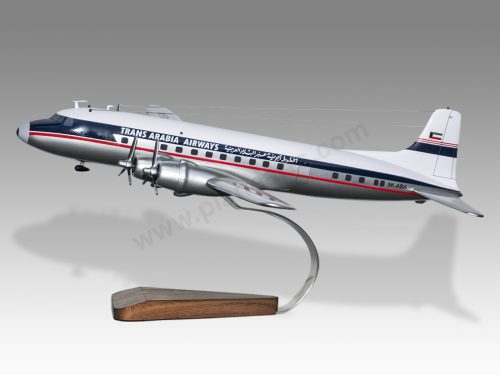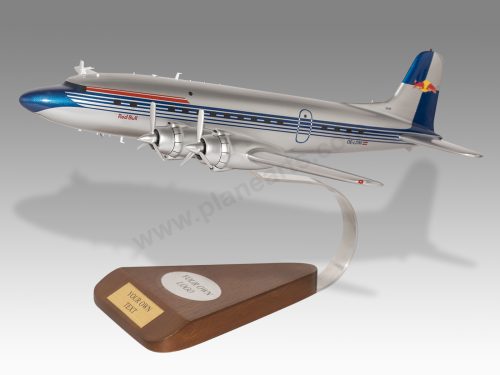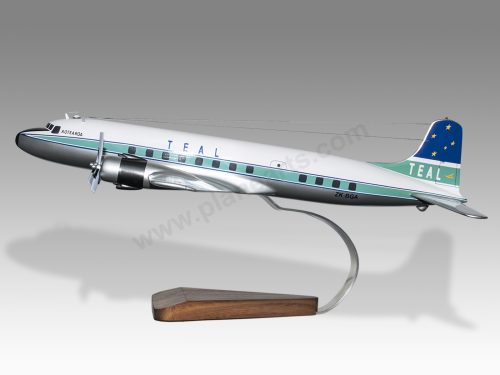Douglas DC-6 Pacific Western
Production Time 9 to 10 weeks
Shipment is by FedEx, UPS or DHL International Express Courier with a normal door-to-door delivery time worldwide of within 2-3 business days after dispatch. Due to the current volatility of world fuel prices, the amount mentioned here is our best estimate for DHL and UPS and may be subject to change at the time of shipping.

Model Description: Douglas DC-6 Pacific Western Wood Replica Scale Custom Model Aircraft
Manufacturer: Douglas
Wingspan: 17 Inches (43.2 Centimeters)
Height: 4.1 Inches (10.4 Centimeters)
Scale: 1:83
Registration: CF-PWA
$239.50
Production Time 9 to 10 weeks
-
United States dollar ($)
-
Pound sterling (£)
-
Euro (€)
-
Australian dollar ($)
-
Canadian dollar ($)
-
Singapore dollar ($)
-
Swiss franc (CHF)
-
Japanese yen (¥)
-
Danish krone (kr.)
-
Hong Kong dollar ($)
-
Norwegian krone (kr)
-
Swedish krona (kr)
-
United Arab Emirates dirham (د.إ)
General Product Description
Our PlaneArts Douglas DC-6 Pacific Western model exhibits unique, unrivaled quality and detailed design to come as close as possible to the accuracy of the actual plane. It comes as standard with a robust, durable base or stand which is available in a variety of different finishes designed to match your own personal requirements including solid wood, wood with polished metal supports or adjustable wood wall mount and will be ready within about 9-10 weeks from placement of order.
The Douglas DC-6 Pacific Western model is made of the finest kiln dried renewable mahogany wood (commonly known as Lauan or Meranti) which has undergone many stages of carving and meticulous and careful sanding giving the beautiful finished museum quality masterpiece. Many collectors and model connoisseurs demonstrate their preference for genuine handmade and hand painted mahogany wood models rather than plastic or die cast (diecast) alternatives due to the overall look and totally different feel of the item - we trust you will find the same. We can, however, if required produce the same model in Solid Cast Resin so just click and contact us us for further information. Our craftsmen and gifted artisans ensure that our finely handcrafted model airplanes match the precise blueprint details of the original aircraft. The paint scheme, markings and parts are closely matched, reflecting the original aircraft. This stylish top-quality desktop replica model will surely enthrall anyone who receives this as a gift and for sure one of the most appropriate and desirably collectable gifts for any aviation enthusiast and avid aircraft collector whilst also displaying a perfect resemblance to the actual aircraft.
If you require we can also make the Douglas DC-6 Pacific Western model in any other airline, private livery or colour scheme you require and if necessary in a different size or scale. Just click here to contact us with a description or photographs of what you require, and we will let you have a quotation for the necessary customization by return email. We can also make bespoke scale replicas of any other private / civil commercial airliner or airliners, helicopter, glider, gliders with engines, military jet, warplane jets, propeller warplanes, biplane, triplane, tail fin, spacecraft, rocket or NASA model you require in any airline, military or civilian livery or colors. We also produce model airships, blimp, dirigible, blimps, boat and ship collectibles. Wall plaque or seal for military, government or private customers. Again, by clicking here to contact us just let us know exactly what you need.
As you may or may not be aware the trade name and copyright permissions for Douglas aircraft are now under the ownership of the Boeing Company and as such, we are proud to be one of the very few international and fully licensed manufacturers of Boeing solid mahogany wood models. You may be interested to read more about the fascinating background to the famous aviation names now under the Boeing umbrella by clicking on the following “Officially Licensed Product” image below:
The Douglas DC-6 Pacific Western: An Icon of Aerial Innovation
The Douglas DC-6, specifically as operated by Pacific Western, represents a significant chapter in the history of commercial aviation. This venerable aircraft, introduced in the late 1940s, was among the last of the great piston-engine airliners before the jet age took full swing. Its service with Pacific Western highlights its versatility and reliability in various operational contexts, including passenger transport, cargo flights, and even aerial firefighting.
Important Features of the Douglas DC-6:
- Versatility and Adaptability: The DC-6 was notable for its ability to operate in diverse environments, from the cold Canadian North to the tropics. Pacific Western’s use of the aircraft for both passenger and cargo services, as well as its later conversion into water bombers for firefighting, underscores its adaptability.
- Long Range and Endurance: With a range of up to 4,900 miles (depending on the model and load), the DC-6 was capable of transcontinental and transatlantic flights, making it a workhorse for international and long-distance domestic flights.
- Comfort and Capacity: In its heyday, the DC-6 was lauded for its passenger comfort. It could accommodate up to 102 passengers in a high-density configuration, though typical configurations were more spacious. Its pressurized cabin was a notable advancement over earlier models like the DC-4, offering a more comfortable flying experience at higher altitudes.
- Economic Operation: Despite being overshadowed by jet aircraft in terms of speed, the DC-6 was economically viable for many airlines, including Pacific Western. Its reliability and lower operating costs for medium-haul routes made it a valuable asset.
Technical Features of the Douglas DC-6:
- Engines: The DC-6 was powered by four Pratt & Whitney R-2800 Double Wasp radial engines, each producing up to 2,500 hp. These engines were known for their durability and were a common sight on many post-war aircraft.
- Performance: The aircraft had a maximum speed of about 315 mph (507 km/h) and a cruising speed of 290 mph (467 km/h). Its service ceiling reached up to 25,000 feet, with a rate of climb that allowed it to surmount most weather disturbances comfortably.
- Dimensions: The DC-6 had a wingspan of 117 feet 6 inches (35.8 meters), a length of 100 feet 7 inches (30.7 meters), and a height of 28 feet 5 inches (8.7 meters), making it significantly larger than its predecessors.
- Payload and Capacity: Depending on the configuration, the DC-6 could carry a significant payload in addition to passengers, making it ideal for mixed-use operations. Its cargo doors and strengthened floors facilitated the transportation of heavy and oversized items.
- Safety and Reliability: Enhanced navigation equipment, redundant systems, and the introduction of weather radar in later models improved the safety profile of the DC-6. Its four-engine configuration offered better redundancy over twin-engine aircraft, an essential factor in its use over remote areas and oceans.
In conclusion, the Douglas DC-6, as operated by Pacific Western, was a testament to the engineering and operational capabilities of the mid-20th century. It bridged the gap between the early days of commercial aviation and the dawn of the jet age, serving with distinction in various roles well beyond its initial expectations. The DC-6 remains a beloved figure among aviation enthusiasts and a symbol of an era when propeller-driven airliners ruled the skies.
| Weight | 6 kg |
|---|---|
| Dimensions | 15.3 × 17 × 4.1 in |
Be the first to review “Douglas DC-6 Pacific Western” Cancel reply
Similar Models
Private & Civilian
Private & Civilian
Private & Civilian
Private & Civilian
Private & Civilian
Private & Civilian
Private & Civilian
Private & Civilian
Private & Civilian
Private & Civilian
Private & Civilian
Private & Civilian
Private & Civilian
Private & Civilian
Private & Civilian
Private & Civilian
Private & Civilian
Private & Civilian
Private & Civilian





























Reviews
There are no reviews yet.